This article needs additional citations for verification .(January 2009) |
A ski simulator is an installation or device which allows the user to mimic the actions of snow skiing without a snow-covered expanse of terrain.
This article needs additional citations for verification .(January 2009) |
A ski simulator is an installation or device which allows the user to mimic the actions of snow skiing without a snow-covered expanse of terrain.
Simulators are primarily used for endurance [1] and technique training, which can take place off-season, indoors or outside the snow belt. The level of fidelity ranges from home exercise equipment (simulating the classic Nordic cross-country stride or the slalom side to side motion) [2] to immersive Virtual Reality systems [3] [4] in Olympic training centers. [5] Indoor installations permit training to be done in any season.
Balance, control and strength are learned by practice and actively doing training drills and lessons on the ski simulators. [6] [7]
Other analogues feature artificial surfaces or roller equipment.
An endless slope is a sloped treadmill that allows skiers and snowboarders to refine form and strengthen muscles. Practicing on this treadmill that simulates snow allows carving, edging, pressuring, steering, and balance on skis or a snowboard, allowing the rider to experience the same muscle workout as on the mountain while developing the skills needed to gracefully move on snow. Revolving carpet ski simulators and indoor ski slope carpets have been widely installed since the early 1960s. [8] [9] They can be used for introductory training or to improve skills for expert skiers, especially outside the ski season.
An alpine skiing simulator is a conveyor having an inclined surface with a moving multi-layer carpet, made out of a composite material. The band’s movement is directed upwards of the inclined surface towards the skier. Using a remote control, an instructor can set up different skiing conditions. For safety reasons the simulator has a smooth start and a smooth stop of the carpet and emergency stop sensors.[ citation needed ]
To ensure good slipping performance the upper working layer of the carpet is moistened with water, sending a signal from a remote control. In addition to that, if the slipping performance needs to be increased, it is possible to treat the working layer of the carpet with a special concentrate.[ citation needed ]
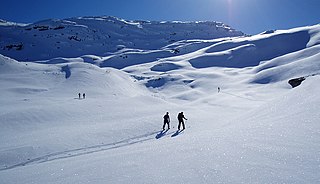
Cross-country skiing is a form of skiing whereby skiers traverse snow-covered terrain without use of ski lifts or other assistance. Cross-country skiing is widely practiced as a sport and recreational activity; however, some still use it as a means of travel. Variants of cross-country skiing are adapted to a range of terrain which spans unimproved, sometimes mountainous terrain to groomed courses that are specifically designed for the sport.

Skiing is the use of skis to glide on snow. Variations of purpose include basic transport, a recreational activity, or a competitive winter sport. Many types of competitive skiing events are recognized by the International Olympic Committee (IOC), and the International Ski and Snowboard Federation (FIS).
A ski is a narrow strip of semi-rigid material worn underfoot to glide over snow. Substantially longer than they are wide, and characteristically employed in pairs, skis are attached to ski boots with ski bindings, with either a free, lockable, or partially secured heel. For climbing slopes, ski skins can be attached at the base of the ski.

Alpine skiing, or downhill skiing, is the pastime of sliding down snow-covered slopes on skis with fixed-heel bindings, unlike other types of skiing, which use skis with free-heel bindings. Whether for recreation or for sport, it is typically practiced at ski resorts, which provide such services as ski lifts, artificial snow making, snow grooming, restaurants, and ski patrol.

A dry ski slope or artificial ski slope is a ski slope that mimics the attributes of snow using materials that are stable at room temperature, to enable people to ski, snowboard or snow tube in places where natural, snow-covered slopes are inconvenient or unavailable.

Inline skating is a multi-disciplinary sport and can refer to a number of activities practiced using inline skates. Inline skates typically have two to five polyurethane wheels depending on the style of practice, arranged in a single line by a metal or plastic frame on the underside of a boot. The in-line design allows for greater speed and maneuverability than traditional roller skates. Following this basic design principle, inline skates can be modified to varying degrees to accommodate niche disciplines.
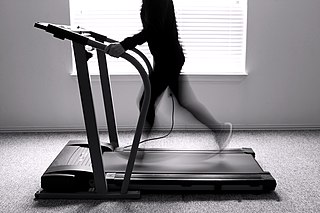
A treadmill is a device generally used for walking, running, or climbing while staying in the same place. Treadmills were introduced before the development of powered machines to harness the power of animals or humans to do work, often a type of mill operated by a person or animal treading the steps of a treadwheel to grind grain. In later times, treadmills were used as punishment devices for people sentenced to hard labour in prisons. The terms treadmill and treadwheel were used interchangeably for the power and punishment mechanisms.
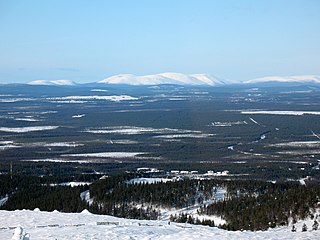
Levi is a fell located in Finnish Lapland, and the largest ski resort in Finland. The resort is located in the village of Sirkka, Kittilä municipality and is served by Kittilä Airport and Kolari railway station. At a latitude of 67.8° north, it is located approximately 170 km (110 mi) north of the Arctic Circle.

A carved turn is a skiing and snowboarding term for the technique of turning by shifting the ski or snowboard onto its edges. When edged, the sidecut geometry causes the ski to bend into an arc, and the ski naturally follows this arc shape to produce a turning motion. The carve is efficient in allowing the skier to maintain speed because, unlike the older stem Christie and parallel turns, the skis do not create drag by sliding sideways.

Ski geometry is the shape of the ski. Described in the direction of travel, the front of the ski, typically pointed or rounded, is the tip, the middle is the waist and the rear is the tail. Skis have four aspects that define their basic performance: length, width, sidecut and camber. Skis also differ in more minor ways to address certain niche roles. For instance, skis for moguls are much softer to absorb shocks from the quick and sharp turns of the moguls and skis for powder are much wider to provide more "float" in deeper, softer snow.

Roller skiing is an off-snow equivalent to cross-country skiing. Roller skis have wheels on their ends and are used on a hard surface, to emulate cross-country skiing. The skiing techniques used are very similar to techniques used in cross-country skiing on snow.

An omnidirectional treadmill (ODT) is a mechanical device, similar to a typical treadmill, that allows a person to perform locomotive motion in any direction, allowing for 360 degrees of movement. The ability to move in any direction is how these treadmills differ from their basic counterparts.
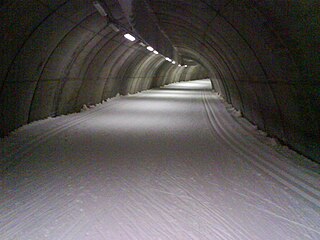
Indoor skiing is done in a climate-controlled environment with artificially produced snow. This enables skiing and snowboarding to take place regardless of outdoor temperatures. Facilities for both alpine skiing and nordic skiing are available.

Berkshire East Ski Resort is a medium-sized alpine ski area in the northeastern United States, located in the Berkshires on Mount Institute in Charlemont and Hawley, Massachusetts.
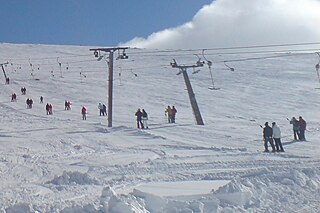
A surface lift is a type of cable transport for snow sports in which skiers and snowboarders remain on the ground as they are pulled uphill. While they were once prevalent, they have been overtaken in popularity by higher-capacity and higher-comfort aerial lifts, such as chairlifts and gondola lifts. Today, surface lifts are most often found on beginner slopes, small ski areas, and peripheral slopes. They are also often used to access glacier ski slopes because their supports can be anchored in glacier ice due to the lower forces and realigned due to glacier movement.
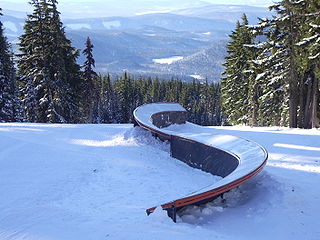
The following outline is provided as an overview of and topical guide to skiing:

The Virtuix Omni is an omnidirectional treadmill simulator for virtual reality games and other applications. It uses a platform to simulate locomotion i.e. the motion of walking, requiring both special shoes or shoe covers and a surface that reduces friction. It works in conjunction with the HTC Vive, and allows a Vive user to physically walk within a limited number of supported games.

Competitive cross-country skiing encompasses a variety of race formats and course lengths. Rules of cross-country skiing are sanctioned by the International Ski Federation and by various national organizations. International competitions include the FIS Nordic World Ski Championships, the FIS Cross-Country World Cup, and at the Winter Olympic Games. Such races occur over homologated, groomed courses designed to support classic (in-track) and freestyle events, where the skiers may employ skate skiing. It also encompasses cross-country ski marathon events, sanctioned by the Worldloppet Ski Federation, and cross-country ski orienteering events, sanctioned by the International Orienteering Federation. Related forms of competition are biathlon, where competitors race on cross-country skis and stop to shoot at targets with rifles, and paralympic cross-country skiing that allows athletes with disabilities to compete at cross-country skiing with adaptive equipment.
This glossary of skiing and snowboarding terms is a list of definitions of terms and jargon used in skiing, snowboarding, and related winter sports.

Ski Santa Fe or Santa Fe Ski Basin is a medium-sized ski resort located in the Sangre de Cristo Mountains in Santa Fe County, New Mexico, United States, 16 miles east of the state capital of Santa Fe. It includes 8 lifts and 88 runs at elevations of over 10,000 feet (3,000 m). It is the southernmost major ski resort of the Rocky Mountains, and one of the oldest and highest in the nation.